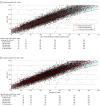Individual Variation in the Distribution of Apolipoprotein B Levels Across the Spectrum of LDL-C or Non-HDL-C Levels
- PMID: 38865115
- PMCID: PMC11170451
- DOI: 10.1001/jamacardio.2024.1310
Individual Variation in the Distribution of Apolipoprotein B Levels Across the Spectrum of LDL-C or Non-HDL-C Levels
Abstract
Importance: Although apolipoprotein B (apoB) is a superior marker of lipid-related risk compared with low-density lipoprotein cholesterol (LDL-C), few data exist to translate the goals and thresholds from LDL-C to their apoB equivalent. In addition, although current American College of Cardiology/American Heart Association guidelines provide a relative indication for apoB measurement among individuals with hypertriglyceridemia, whether discordance is limited to those subgroups is unknown.
Objectives: To assess the variability in apoB level across the spectrum of LDL-C or non-high-density lipoprotein cholesterol (non-HDL-C) levels and evaluate whether discordance between apoB and LDL-C or non-HDL-C is limited to specifiable subgroups.
Design, setting, and participants: This cross-sectional study used data from a nationally representative sample of 12 688 adult participants not using statins in the National Health and Nutrition Examination Survey between 2005 and 2016. Statistical analysis was performed from April 2023 to February 2024.
Main outcomes and measures: Quantile regression was used to assess the population distribution of apoB across LDL-C or non-HDL-C levels. Discordance between apoB and LDL-C was the difference between measured apoB and median apoB levels for an individual's LDL-C level. Discordance was evaluated by age, sex, race and ethnicity, obesity, diabetes, triglyceride level, hemoglobin A1c level, body mass index (BMI), statin use, and metabolic health (defined as a BMI between 18.5 and 24.9, triglyceride level <150 mg/dL, and no diabetes).
Results: Among the sample of 12 688 participants (median age, 41.0 years [IQR, 29.0-54.0 years]; 52.9% women) for LDL-C values of 55, 70, 100, and 190 mg/dL, the corresponding population median apoB levels were 49, 60, 80, and 140 mg/dL, respectively. For given levels of LDL-C, a range of apoB values was observed. At an LDL-C level of 100 mg/dL, the 95% population distribution of apoB ranged from 66 mg/dL to 99 mg/dL. ApoB variability was highest for LDL-C values estimated using the Friedewald equation, lower when using Sampson or Martin-Hopkins equations, and lowest for non-HDL-C. Although individuals with metabolic risk factors were more likely to have discordantly high apoB levels (ie, had higher median observed apoB levels relative to what was estimated based on LDL-C), significant variability in apoB levels was observed even among metabolically healthy individuals.
Conclusions and relevance: This study suggests that even metabolically healthy individuals may have discordantly high apoB levels relative to LDL-C or non-HDL-C levels. The current guideline approach for apoB testing only for those with hypertriglyceridemia appears too narrow. Population percentile data can be used to translate LDL-C goals and thresholds to their apoB equivalent to facilitate clinical adoption.
Conflict of interest statement
Figures



References
-
- Marston NA, Giugliano RP, Melloni GEM, et al. Association of apolipoprotein B–containing lipoproteins and risk of myocardial infarction in individuals with and without atherosclerosis: distinguishing between particle concentration, type, and content. JAMA Cardiol. 2022;7(3):250-256. doi: 10.1001/jamacardio.2021.5083 - DOI - PMC - PubMed
-
- Sniderman AD, Williams K, Contois JH, et al. A meta-analysis of low-density lipoprotein cholesterol, non–high-density lipoprotein cholesterol, and apolipoprotein B as markers of cardiovascular risk. Circ Cardiovasc Qual Outcomes. 2011;4(3):337-345. doi: 10.1161/CIRCOUTCOMES.110.959247 - DOI - PubMed
MeSH terms
Substances
LinkOut - more resources
Full Text Sources
Medical
Miscellaneous

